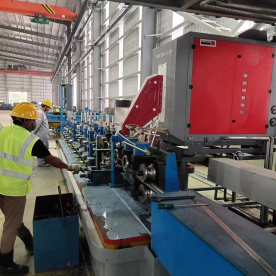
In the ever-evolving landscape of manufacturing, particularly in the metalworking sector, the role of precision tools cannot be overstated. One such crucial component is the mould for tube mills. Tube mills are essential machines used in the production of both welded and seamless tubes, which are vital across various industries including construction, automotive, and energy. A well-designed and properly maintained mould plays a pivotal role in determining the efficiency of the tube-making process and the quality of the final product. This article delves into the significance of moulds in tube mills, exploring their design, functionality, and impact on manufacturing processes.
The Basics of Tube Mill Technology
Before delving into the specifics of moulds, it is important to understand what a tube mill does. Tube mills are machines that employ a series of rotating rollers to form metal strips into tubes. These machines can produce tubes of various sizes and thicknesses depending on the needs of the consumer. The process involves the heating of metal, commonly steel, followed by shaping and welding or seamless processing to create a cylindrical product. The mould is integral to this process as it provides the necessary shape and size consistency for the produced tubes.
The Functionality of Moulds in Tube Mills

Moulds serve several essential functions in tube mills:

1. **Shape and Size Specification**: The primary role of a mould is to provide the desired shape and size to the tube during the forming process. A precisely designed mould ensures that the tube meets specific dimensional requirements, which is critical for applications where precision is key.
2. **Supporting Structural Integrity**: Moulds assist in maintaining the structural integrity of the tube throughout the manufacturing process. They provide the necessary support to prevent deformation during cooling and solidification, which is especially important for welded tubes.
3. **Optimizing Material Flow**: Effective mould design can significantly enhance material flow during the forming process. This optimization can lead to reduced wastage of raw materials, as well as improved throughput, thus maximizing productivity and operational efficiency.
4. **Ensuring Surface Finish**: The contact between the metal and the mould dictates the surface finish of the produced tubes. High-quality moulds made from durable materials help to ensure a smooth finish, reducing the need for additional finishing processes, which can be costly and time-consuming.
Design Considerations for Moulds

Designing a mould for tube mills involves several considerations to ensure that it meets the operational requirements:
– **Material Selection**: The material used for mould construction should be robust and capable of withstanding high temperatures and pressures. Common materials include high-strength steel and other alloys that exhibit durability and wear resistance.
– **Thermal Conductivity**: A well-designed mould should have optimal thermal conductivity to ensure uniform temperature distribution during the metal forming process. This helps in preventing hot spots that may lead to defects in the finished product.
– **Ease of Replacement and Maintenance**: Given the wear and tear that moulds experience, it is essential to design them for easy replacement and maintenance. This consideration helps in reducing downtime, which can significantly impact production efficiency.
Impact on Manufacturing Efficiency
The efficiency of tube mills can be directly attributed to the effectiveness of the moulds used. High-quality moulds contribute to reduced cycle times, lower rejection rates, and enhanced product quality. As manufacturers strive to remain competitive in an increasingly global market, investing in advanced mould technology becomes imperative.
Moreover, modern tube mills increasingly incorporate automation and advanced monitoring systems which require precisely calibrated moulds to function optimally. As technology advances, the integration of smart moulds with sensors that provide real-time feedback can further enhance performance, allowing for on-the-fly adjustments that minimize defects.
Conclusion
In conclusion, the mould for tube mill is more than just a tool; it is a fundamental element that dictates the quality and efficiency of tube production processes. As industries continue to demand higher precision and quality from manufacturers, the importance of investing in advanced mould technology cannot be overlooked. By focusing on the design, materials, and maintenance of moulds, manufacturers can not only improve their operational efficiencies but also elevate the overall quality of their products, ensuring their competitiveness in the marketplace. As we move forward, embracing innovation in mould technology will be crucial for sustainable growth in the tube manufacturing sector.Cost-effective ERW tube mill options